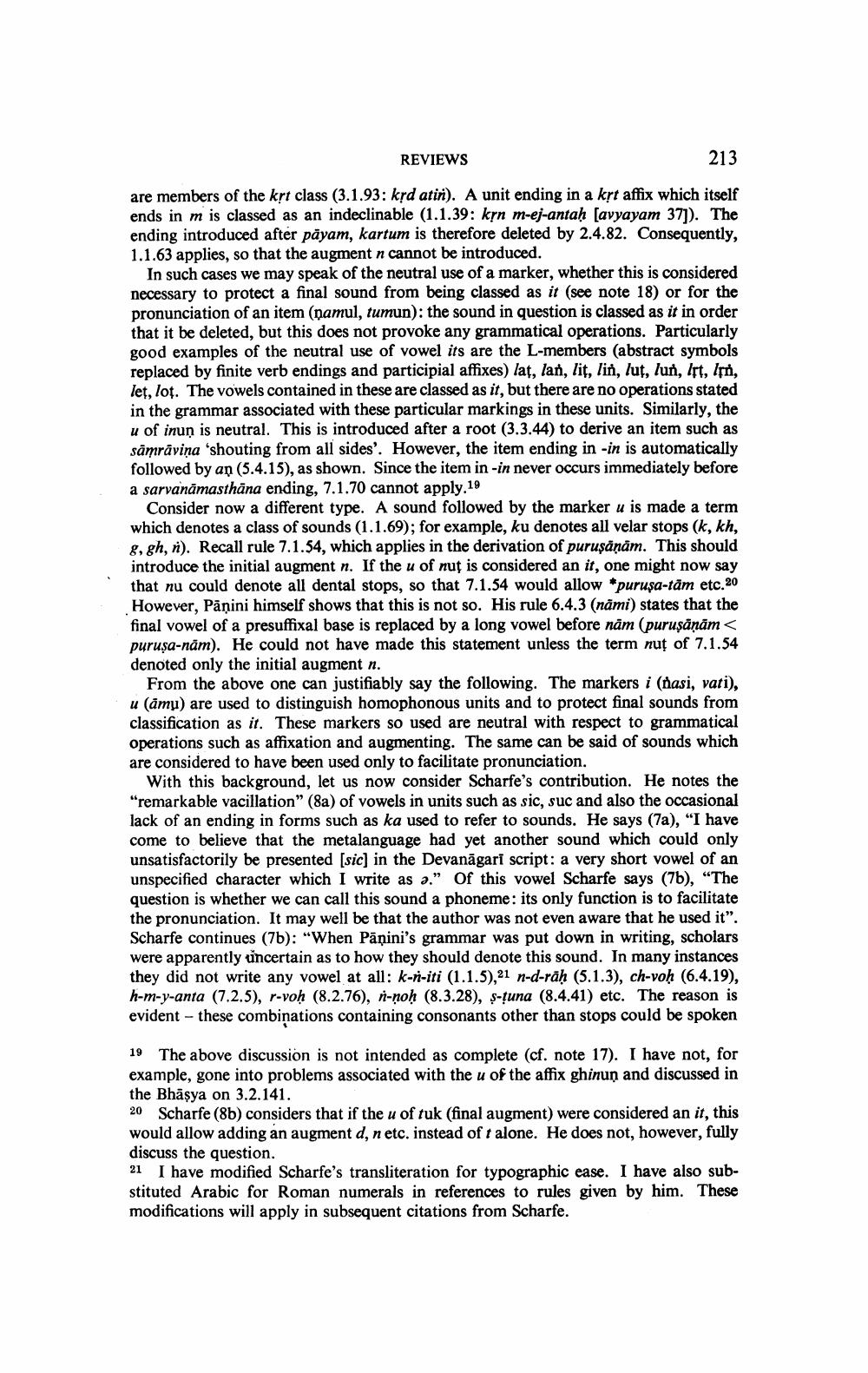Book Title: Reviews Of Different Books Author(s): Publisher: View full book textPage 7
________________ REVIEWS 213 are members of the krt class (3.1.93; krd atin). A unit ending in a krt affix which itself n is classed as an indeclinable (1.1.39: krn m-ej-antah savyayam 371). The ending introduced after payam, kartum is therefore deleted by 2.4.82. Consequently, 1.1.63 applies, so that the augment n cannot be introduced. In such cases we may speak of the neutral use of a marker, whether this is considered necessary to protect a final sound from being classed as it (see note 18) or for the pronunciation of an item (namul, tumun): the sound in question is classed as it in order that it be deleted, but this does not provoke any grammatical operations. Particularly good examples of the neutral use of vowel its are the L-members (abstract symbols replaced by finite verb endings and participial affixes) lat, lan, lit, lin, lut, lun, Irt, Imo, let, lot. The vowels contained in these are classed as it, but there are no operations stated in the grammar associated with these particular markings in these units. Similarly, the u of inun is neutral. This is introduced after a root (3.3.44) to derive an item such as samravina 'shouting from all sides'. However, the item ending in -in is automatically followed by an (5.4.15), as shown. Since the item in -in never occurs immediately before a sarvanamasthana ending, 7.1.70 cannot apply. 19 Consider now a different type. A sound followed by the marker u is made a term which denotes a class of sounds (1.1.69); for example, ku denotes all velar stops (k, kh, 8, gh, n). Recall rule 7.1.54, which applies in the derivation of purusanam. This should introduce the initial augment n. If the u of nut is considered an it, one might now say that nu could denote all dental stops, so that 7.1.54 would allow *purusa-tam etc. 20 However, Panini himself shows that this is not so. His rule 6.4.3 (nami) states that the final vowel of a presuffixal base is replaced by a long vowel before nam (purusanam< purusa-nam). He could not have made this statement unless the term nut of 7.1.54 denoted only the initial augment n. From the above one can justifiably say the following. The markers i (nasi, vati), u (amu) are used to distinguish homophonous units and to protect final sounds from classification as it. These markers so used are neutral with respect to grammatical operations such as affixation and augmenting. The same can be said of sounds which are considered to have been used only to facilitate pronunciation. With this background, let us now consider Scharfe's contribution. He notes the "remarkable vacillation" (sa) of vowels in units such as sic, suc and also the occasional lack of an ending in forms such as ka used to refer to sounds. He says (7a), "I have come to believe that the metalanguage had yet another sound which could only unsatisfactorily be presented (sic) in the Devanagari script: a very short vowel of an unspecified character which I write as a." Of this vowel Scharfe says (76), "The question is whether we can call this sound a phoneme: its only function is to facilitate the pronunciation. It may well be that the author was not even aware that he used it". Scharfe continues (7b): "When Panini's grammar was put down in writing, scholars were apparently uncertain as to how they should denote this sound. In many instances they did not write any vowel at all: k-r-iti (1.1.5),21 n-d-rah (5.1.3), ch-voh (6.4.19), h-m-y-anta (7.2.5), r-voh (8.2.76), n-noh (8.3.28), s-tuna (8.4.41) etc. The reason is evident - these combinations containing consonants other than stops could be spoken tinguish hon used are name can be 19 The above discussion is not intended as complete (cf. note 17). I have not, for example, gone into problems associated with the u of the affix ghinun and discussed in the Bhasya on 3.2.141. 20 Scharfe (85) considers that if the u of tuk (final augment) were considered an it, this would allow adding an augment d, n etc. instead of t alone. He does not, however, fully discuss the question. 21 I have modified Scharfe's transliteration for typographic ease. I have also substituted Arabic for Roman numerals in references to rules given by him. These modifications will apply in subsequent citations from Scharfe.Page Navigation
1 ... 5 6 7 8 9 10 11 12 13 14 15 16 17 18 19 20 21 22 23 24 25 26 27 28 29 30 31 32 33
